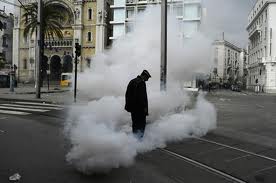Tear gas – a substance used around the world to disperse crowds
Monday, November 21st, 2011 5:38:50 by M. Omer Iqbal bhatti
Tear gas – a substance used around the world to disperse crowds
Trailing white fumes, a silver canister arches over the no-man’s-land between the armored riot police and the bulk of your fellow protesters.
You duck, but the canister falls short and lands amid the people in front of you. The white fumes begin to billow up like fake smoke at a magic show, but there’s nothing fake about the cries you hear. People shriek. They wail. They flee backward through
the crowd, tears and mucus flowing freely from reddened faces. They cough and rub their eyes maddeningly. Some of them double over and retch.
You turn to flee, too, but that’s when the cloud of white powder hits you full in the face. You pinch your eyes shut at the sudden sting. You gasp, and the burning sensation seers its way into your sinuses and down your throat. It’s as if you’ve swallowed
fire.
Forcing your eyes open, you find the world has blurred. The screaming crowd scatters, and all is chaos. You feel as if you’ll never breathe or see again.
Chemists first synthesized CS in the late 1950s as a crowd suppressant. Within a few years, it quickly replaced the less-powerful CN as the go-to tear gas. It remains in use around the world to this day.
Don’t let the tears fool you. Lacrimators are irritants, not mood-altering chemicals. CS gas causes a severe burning sensation upon contact with skin. Your sensory nerves sound the alarm to your brain, sending the memo, "Hey, please remove this awful chemical
from your skin before it physically harms you."
And indeed, prolonged exposure to the CS can cause rashes and chemical burns. When the irritant encounters the human eye, the stakes are much higher. The sensory nerves send a signal to your brain stem, which in turn sends hormones to tear glands in the
eyelids. These glands pump out a salty wash of protein, water, mucus and oil to help rid your sensitive peepers of the irritant as quickly as possible.
This is how tear gas produces tears, but the effects of exposure don’t necessarily stop with the ocular immune system. Inhale CS gas and the burning sensation will kick-start similar defenses in the nose and the respiratory system: flowing mucus and hacking
coughs, all in an attempt to rid the body of its irritant. Nausea and vomiting also may occur.
Yes, you’ve been hit with tear gas, a substance used around the world to disperse crowds and control riot situations. While you’ll probably recover fully in an hour’s time, it’s not an experience you’ll forget. Just what is this dreadful stuff, and why does
it feel like you’ve been licked full in the face by the devil himself?
In this article, we’ll pop open the silver canister and discuss what tear gas is, why it’s legal and what you can do to make the burning stop.
Tags: CN, CS gas, Lacrimators, mucus, Nausea, ocular immune system, Tear gasShort URL: https://www.newspakistan.pk/?p=4202

















